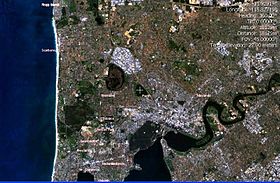Lake Monger, Western Australia
| Lake Monger Keiermulu |
|
|---|---|

NASA World Wind image of Perth, Western Australia with Lake Monger centred at the crosshair
|
|
| Location | Perth, Western Australia |
| Coordinates | 31°55′46″S 115°49′35″E / 31.9294°S 115.8265°ECoordinates: 31°55′46″S 115°49′35″E / 31.9294°S 115.8265°E |
| Type | Wetland |
| Basin countries | Australia |
| Designation | Lake Monger Reserve |
| Surface area | 0.7 km2 (0.27 sq mi) |
| Shore length1 | 4.5 km (2.8 mi) |
| Islands | 1 |
| References | |
| 1 Shore length is not a well-defined measure. | |
Lake Monger (Noongar:Keiermulu) is a large urban wetland on the Swan Coastal Plain in suburban Perth, Western Australia nestled between the suburbs of Leederville, Wembley and Glendalough.
Located less than 5 kilometres (3.1 mi) from the city of Perth and situated alongside the Mitchell Freeway, it runs approximately north-west to south-east towards the Swan River and consists of 70 hectares (170 acres) of mainly open shallow water with an island of 1.3 hectares (3.2 acres) in the south-west corner. The 110 hectares (270 acres) of lake and the surrounding parklands are known as the Lake Monger Reserve.
The lake is used extensively for recreation and is a major tourist attraction with up to 12,000 visitors per week. Activities include bird watching and exercise.
A 3.8-kilometre (2.4 mi) paved walking/cycling track encircles the lake which takes about 50 Minutes to traverse by foot at Normal waking speed. Ample car parking, playground equipment and barbecue facilities are also provided.
The indigenous Noongar people of the south-western region call the area Keiermulu which translates to 'the home fires or camp', or Lake Galup or Lake Kalup.
After European settlement, it became known as either Large Lake or Triangle Lake (based on its roughly triangular shape) before being named Monger's Lake in 1831. In April 1932 it was changed to its current name of Lake Monger.
Little is known about the use of the lake by the Noongars prior to the British settlement other than the area was known to be within the area inhabited by those people. Given its geographical features, it could have been used regularly as a significant camping and hunting site with black swans and other wildfowl as well as turtles, frogs, gilgies and mudfish hunted as food.
...
Wikipedia
